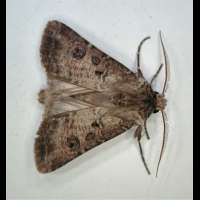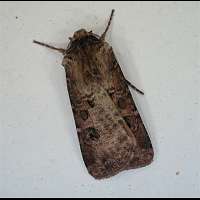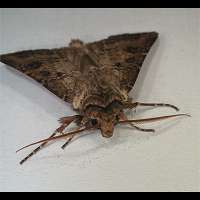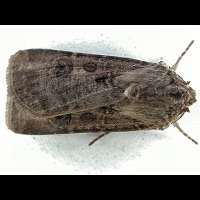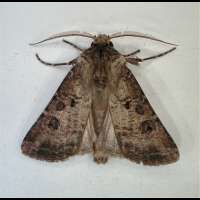Heart and Club Agrotis clavis
The Heart and Club is very similar to the Heart and Dart. Both are yellowish or greyish brown moths with obscure and rather dark markings. And what's more: both are very variable indeed. Especially extremely pale and very dark specimens could present you with a problem. Experts usually tell the Heart and Club apart by looking at the shape of the forewing, which is broad and comparatively blunt. Usually the round spot is accentuated by a black circle, giving an eye-like impression. Finally the Heart and Club does not have a dark collar. And by the way the Turnip Moth is similar as well, but it is usually much greyer, darker and less well marked. Of the three species mentioned the Heart and Club is the smallest, reaching a wingspan of 35 to 40 mm only, even though there's quite some overlap.
The caterpillars of the Heart and Club may be found on the foodplants from August to November. They eat by day and hide on or in the ground by day. In the beginning of december they'll dig a chamber in the ground, where they spend winter. In the same chamber they'll pupate after overwintering. In June next year the first adults will appear. The larva is greyish brown. One, rather vague line runs over the back. It is very similar to the caterpillars of some other darts and very hard to identify. It lives on many low growing herbaceous plants, such as clover, Fat-hen, Dock, knotgrass and wild Carrot, where it may eat both the leaves and the roots. It may reach a length of some 36mm.
The Heart and Club does not fly during the day voluntarily. It is however easily attracted to light and sugar. Doesn't allow itself to be disturbed easily during the day and can be photographed painlessly. A common and sometimes even abundant species on sandy soils, both near the coast and inland. Very common in the Southern half of England. Northwards a rather local species. In other parts of Europe common on sandy soils too, scarce or absent elsewhere.
The Heart and Club is very similar to the Heart and Dart. Both are yellowish or greyish brown moths with obscure and rather dark markings. And what's more: both are very variable indeed. Especially extremely pale and very dark specimens could present you with a problem. Experts usually tell the Heart and Club apart by looking at the shape of the forewing, which is broad and comparatively blunt. Usually the round spot is accentuated by a black circle, giving an eye-like impression. Finally the Heart and Club does not have a dark collar. And by the way the Turnip Moth is similar as well, but it is usually much greyer, darker and less well marked. Of the three species mentioned the Heart and Club is the smallest, reaching a wingspan of 35 to 40 mm only, even though there's quite some overlap.
The caterpillars of the Heart and Club may be found on the foodplants from August to November. They eat by day and hide on or in the ground by day. In the beginning of december they'll dig a chamber in the ground, where they spend winter. In the same chamber they'll pupate after overwintering. In June next year the first adults will appear. The larva is greyish brown. One, rather vague line runs over the back. It is very similar to the caterpillars of some other darts and very hard to identify. It lives on many low growing herbaceous plants, such as clover, Fat-hen, Dock, knotgrass and wild Carrot, where it may eat both the leaves and the roots. It may reach a length of some 36mm.
The Heart and Club does not fly during the day voluntarily. It is however easily attracted to light and sugar. Doesn't allow itself to be disturbed easily during the day and can be photographed painlessly. A common and sometimes even abundant species on sandy soils, both near the coast and inland. Very common in the Southern half of England. Northwards a rather local species. In other parts of Europe common on sandy soils too, scarce or absent elsewhere.

